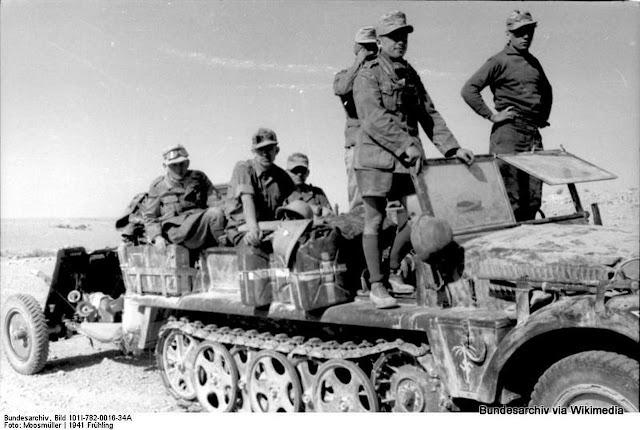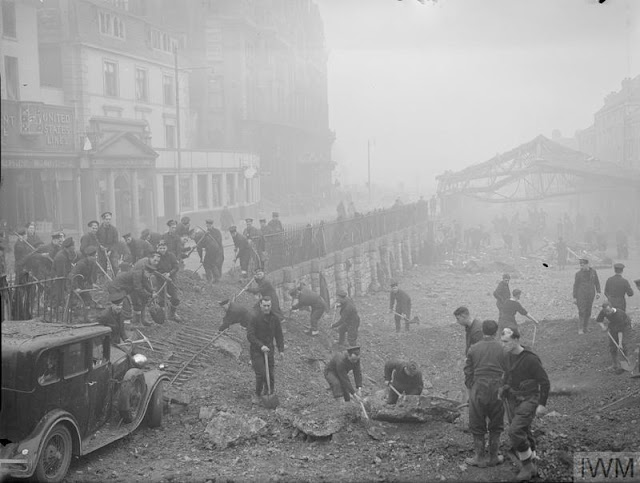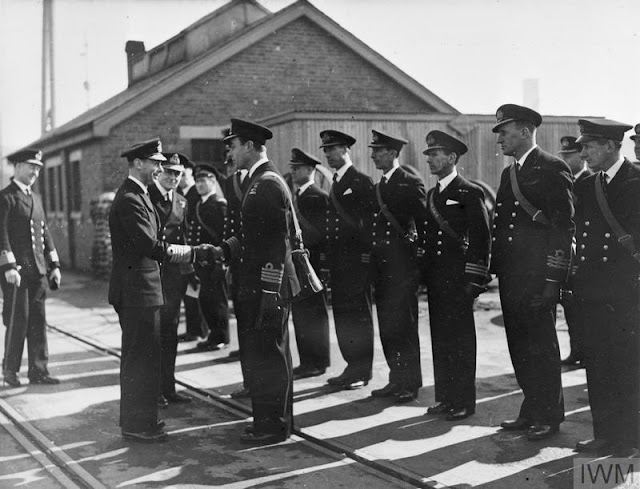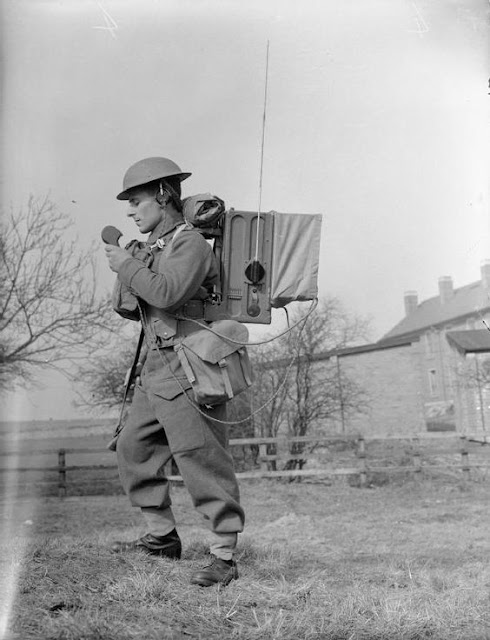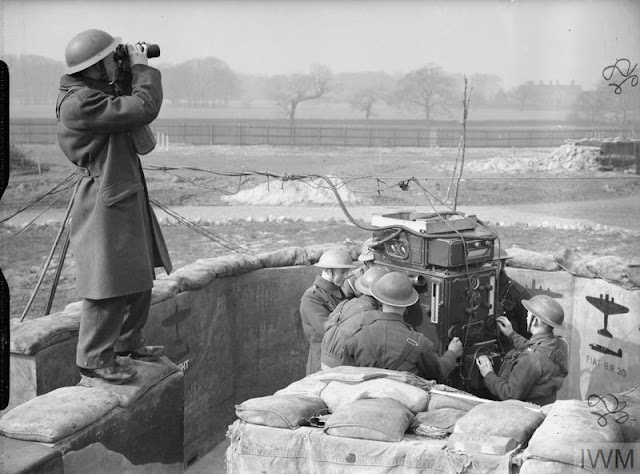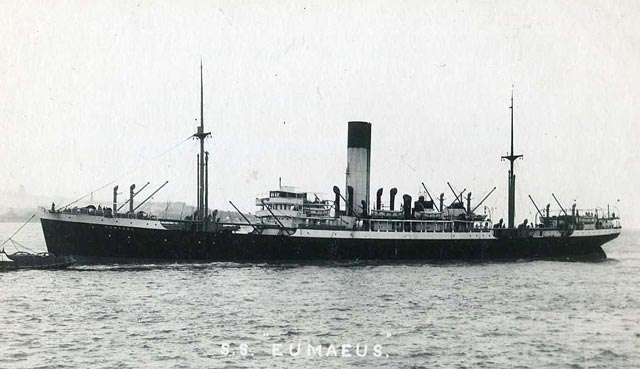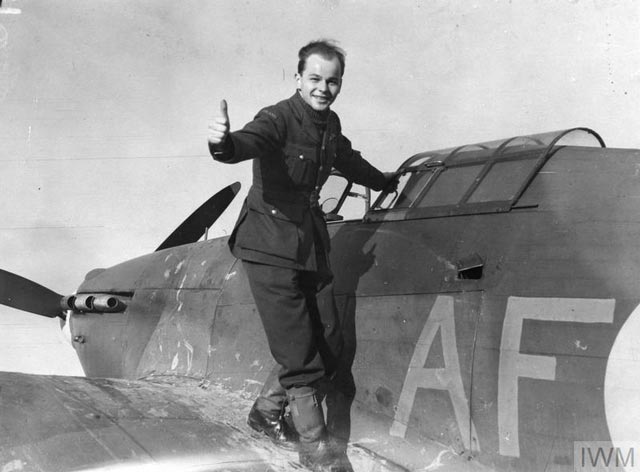Saturday 22 March 1941
 |
| "The first production Beaufighter Mark IIF night fighter, R2270, fitted with dihedral tailplanes and equipped with AI Mark IV radar, in flight. This aircraft served with No. 406 Squadron RCAF." This Bristol Type 156 Beaufighter makes its maiden flight on 22 March 1941 and uses 1200 hp Merlin XX engines. © IWM (MH 4560). |
East African Campaign: The British offensive west of Jijiga, Abyssinia continues. Having occupied the Babile Pass upon an Italian withdrawal during the night, the British also occupy the abandoned city of Harar. Further west, Belgian colonial troops occupy Gambela.
At Keren, the Italians continue to launch fierce attacks to recover Fort Dologorodoc, the fortress to the right of the Dongolaas Gorge. The British troops holding Fort Dologorodoc despite these attacks have got to be wondering why, when the Italians are barely fighting anywhere else, here they are acting like the future of Italy itself depends on this one fort.
 |
| Australian Prime Minister Robert Menzies in Plymouth, 22 March 1941. © IWM (A 3556). |
Cannot enter city of Plymouth today, public being excluded because of delayed action bombs. Hear that the Astor house [mayor of Plymouth], where we were to stay, was bombed!The first production Beaufighter Mark IIF night fighter, R2270, rolls out of the factory and makes its maiden flight. It has dihedral tailplanes, a Merlin engine and is equipped with AI Mark IV radar. It will serve with RCAF No. 406 Squadron.
Battle of the Atlantic: Escorted by destroyers (which meet them at 03:00) and the Luftwaffe, German heavy cruisers Gneisenau and Scharnhorst make port at Brest, France. Gneisenau quickly enters dry dock No. 8 for periodic maintenance. Scharnhorst, berthed alongside the Quai de la Ninon, also requires work on the superheater tubes in her boilers which will keep her in Brest until July. Admiral Lütjens begins packing his bags for his next command - that of the two-ship operation that will include battleship Bismarck in May.
Operation Berlin has been a resounding success, with the two ships sinking or capturing 22 ships totaling about 115,000 tons. While covering 17,800 miles in 60 days, they have terrified Allied convoys throughout the Atlantic and kept the Royal Navy on high alert. If any German Atlantic cruiser proves the value to the Kriegsmarine of surface raiders to wreak destruction and spread out the Allied defenses, Operation Berlin is the one.
The British, despite occasional aircraft sightings of the two ships, remain oblivious of the fact that "Salmon and Gluckstein" (the British nickname for the two German ships, after a tobacco shop) have made port. The Admiralty diverts from another mission four destroyers based at Londonderry (HMS Jackal, Kashmir, Kelly, and Kipling) to search for them, to no avail. Aircraft carrier HMS Ark Royal is forced to divert to Gibraltar after a catapult malfunction leads to one of its own Fairey Swordfish depth charge exploding under the ship, damaging it. All of this illustrates the value to the Germans of having surface ships on the loose, a huge distraction for the Royal Navy.
The Gneisenau and Scharnhorst are far from the only German ships operating with impunity on the high seas. Kriegsmarine raider Kormoran is in the mid-Atlantic between Brazil and Africa when it spots empty 3552-ton British (Shell) tanker Agnita with gunfire. The British crew becomes POWs and the Kormoran scuttles the Agnita using a torpedo, 105 mm gunfire and demolition charges.
The Luftwaffe bombs and sinks 495-ton British freighter St. Fintan about seven miles (12 km) northwest of Smalls Lighthouse, Wales. The crew of nine perishes.
The Luftwaffe bombs 1418-ton Norwegian freighter Inger about ten miles (18 km) south of Smalls. The ship makes it to Plymouth.
The Luftwaffe bombs 2154-ton British freighter Dashwood in the Barrow Deep. The ship makes it to port.
The RAF bombs and damages Norwegian coaster Vestlkyst I off Skadberg, Norway. The captain manages to beach the ship to prevent sinking. However, the RAF later attacks the ship, further damaging it. Eventually, it is refloated and repaired.
Royal Navy destroyer HMS Belmont is damaged in a collision with a freighter about 15 miles northwest of the Isle of Man. It returns to Liverpool for repairs.
Royal Navy destroyers attack U-48 (Kptlt. Herbert Schultze) with depth charges. The U-boat is damaged but gets away. U-48 is on its 11th patrol and is one of the most successful boats in the U-boat fleet, but it is nearing the end of its combat life due to its small size.
Three Royal Navy destroyers (HMS Icarus, Intrepid and Impulsive) lay minefield GN on the English Channel.
U-126 (Kapitänleutnant Ernst Bauer) and U-202 (Kapitänleutnant Hans-Heinz Linder) are commissioned.
 |
| Actor Jimmy Stewart, a recent Oscar winner for Best Actor in "The Philadelphia Story," at his induction ceremony in the US Army. 22 March 1941. |
Things are heating up in North Africa in more ways than one. The Luftwaffe attacks a column of 70 British vehicles driving north from Agedabia. Aerial reconnaissance reports British troops in the area of Sollum/Ghemines/Magrum. Three RAF Hurricanes make a strafing attack on Marada.
The Luftwaffe (III,/KG 30 Junkers Ju 88s) bombs and badly 8070 ton damages Norwegian freighter Solheim south of Crete. Attempts are made to salvage it, but she eventually sinks. All 32 crew survive. Some accounts place the sinking of the 3798 ton Greek freighter Embiricos Nicolaos in this action, others on the 21st.
British 58 ton tug Chabool is presumed lost today of unknown causes. It had departed Aden on 15 March bound for Berbera.
Convoy AN 22 (nine ships) departs Alexandria bound for Piraeus. The New Zealand 6th Infantry Brigade arrives at Piraeus.
An Axis convoy of four ships departs from Naples bound for Tripoli.
Battle of the Indian Ocean: German raider Pinguin completes its resupply from supply ship Alstertor. Fregattenkapitän (later Kapitän zur See) Ernst-Felix Krüder makes plans to finish his refit and depart within the next few days.
Battle of the Pacific: Two of the Italian ships that escaped from East Africa before their port, Massawa, was captured arrive in Kobe, Japan. These are auxiliary cruiser Ramb II and Italian colonial sloop Eritrea. Virtually all of the other ships have been captured, scuttled or sunk.
 |
| Visiting Australian Prime Minister Robert Menzies during his visit to Plymouth, 22 March 1941. Commander-in-Chief Plymouth Command, Admiral Sir Dunbar-Nasmith, VC KCB, greets him. © IWM (A 3558). |
Humanitarian Aid: President Roosevelt has been advocating the shipment of humanitarian aid to Occupied Europe since 1940. However, the British - primarily Prime Minister Winston Churchill - have objected on the grounds that this helps the Wehrmacht. British approval is necessary to get such supplies through the Royal Navy blockade. Today, the British approve of the passage of two ships carrying American flour to Vichy France.
US Military: Actor Jimmy Stewart begins a long military career when he reports for induction at Fort McArthur, California. He begins his career as a private, serial number 0433210. Stewart still has to send his agent in Hollywood 10% of his $21 per month army salary. An accomplished private pilot, Stewart is heading for service in the US Army Air Corps.
Vichy French Government: Vichy French President Philippe Pétain signs a decree to construct a trans-Saharan railway. Plans are to cut costs by using POWs and concentration camp inmates.
 |
| The Beechcraft D17A sitting atop the mammoth Snow Cruiser. |
China: The Battle of Shanggao continues. Today, the main action shifts to the air, where the Japanese attack the next Chinese defensive line (the second of three). This attack is successful, leading to the deaths of 100-200 Chinese soldiers. The Japanese 11th Army ground forces then advance through the breach created, using a formula perfected by the Germans: tanks and armored cars first, followed by infantry. However, the Chinese forces on the flanks of the breach are intact, and they rain fire on the Japanese. After losing about half of their vehicles and infantry, the Japanese retreat. The Japanese are not willing to give up and launch a poison-gas attack, one of the few during World War II. The Chinese, however, abandon the second defensive line before the poison gas shells are launched, so the poison gas largely falls in unmanned areas.
 |
| The Grand Coulee Dam in Washington State as pictured in 1941 (Wikimedia Commons/Library of Congress). |
Future History: Edward Heath is commissioned as a Second Lieutenant in the Royal Regiment of Artillery. Lt. Heath will go on to become the Prime Minister of England from 1970-1974.
 |
| The Beechcraft D17A Staggerwing and Curtiss R4C-l Condor assigned to the West Base of the U.S. Antarctic Service. The Staggerwing was designed to be carried on the roof of the giant Snow Cat and, on 31 January 1941, was shipped out on the USS North Star and returned to the US. It quickly was sold off to an Australian citizen from Alice Springs and was destroyed in an accident on 22 December 1963. The Condor, meanwhile, had good carrying capacity but was old and creaky. After being used on 22 March 1941 to evacuate the last personnel from Little America, the plane was left in the Antarctic, where it remains (Wings Magazine, February 1980). |
March 1941
March 1, 1941: Rettungsboje
March 2, 1941: Oath of Kufra
March 3, 1941: Germans in Bulgaria
March 4, 1941: Lofoten Islands Raid
March 5, 1941: Cooperation With Japan
March 6, 1941: Battle of Atlantic
March 7, 1941: Prien Goes Under
March 8, 1941: Cafe de Paris
March 9, 1941: Italian Spring Offensive
March 10, 1941: Humanitarian Aid
March 11, 1941: Lend Lease Becomes Law
March 12, 1941: A New Magna Carta
March 13, 1941: Clydeside Wrecked
March 14, 1941: Leeds Blitz
March 15, 1941: Cruisers Strike!
March 16, 1941: Kretschmer Attacks
March 17, 1941: Happy Time Ends
March 18, 1941: Woolton Pie
March 19, 1941: London Hit Hard
March 20, 1941: Romeo and Juliet
March 21, 1941: Plymouth Blitz
March 22, 1941: Grand Coulee Dam
March 23, 1941: Malta Under Siege
March 24, 1941: Afrika Korps Strikes!
March 25, 1941: Yugoslavia Joins The Party
March 26, 1941: Barchini Esplosivi
March 27, 1941: Belgrade Coup
March 28, 1941: Cape Matapan Battle
March 29, 1941: Lindbergh Rants
March 30, 1941: Commissar Order
March 31, 1941: Cookie Bombs
2020






